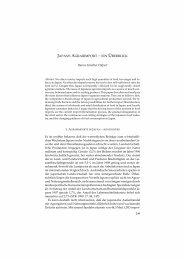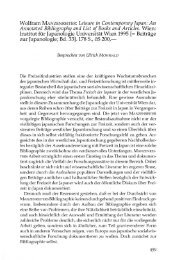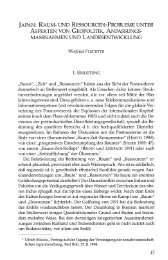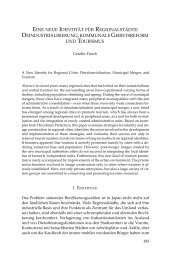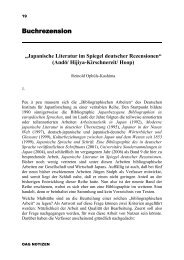TAMPOPO: FOOD AND THE POSTMODERN IN THE WORK ... - DIJ
TAMPOPO: FOOD AND THE POSTMODERN IN THE WORK ... - DIJ
TAMPOPO: FOOD AND THE POSTMODERN IN THE WORK ... - DIJ
You also want an ePaper? Increase the reach of your titles
YUMPU automatically turns print PDFs into web optimized ePapers that Google loves.
<strong>TAMPOPO</strong>: <strong>FOOD</strong> <strong>AND</strong> <strong>THE</strong> <strong>POSTMODERN</strong> <strong>IN</strong> <strong>THE</strong> <strong>WORK</strong><br />
OF ITAMI JÛZÔ<br />
Timothy Iles<br />
Abstract: Itami Jûzô’s film Tampopo possesses a structure and thematic richness that<br />
make it a prime example of postmodern film-making. Its use of food as visual metaphor<br />
and narrative device works together with its structure to privilege a decentred<br />
approach to plot, character, and story-telling. At the same time, the film’s subject<br />
matter and the series of vignettes which interfere with – while equally creating<br />
– its narrative flow reflect a cultural cosmopolitanism common in Japan by the time<br />
of the film’s production. This paper will argue that Tampopo can be read as a rebuttal<br />
of certain political attitudes that seek to present Japan as culturally homogeneous,<br />
socially stable, and ethnically unified. The film achieves this objective by offering<br />
a theoretically aware vision of Japan as composed of infinite and equal<br />
fragments held together only by convention, a vision of Japan as postmodern.<br />
Food plays such a dominant, even defining, role in any culture that frequently<br />
when asked to name one’s favourite food, one replies with the<br />
name of a nationality rather than a dish. Yet food also possesses the double-edged<br />
potential to demonstrate its consumers’ sophistication and/or<br />
cultural appropriation. It is with this particular potential that Itami Jûzô’s<br />
popularly successful though academically overlooked 1986 film Tampopo<br />
plays, for this work of comedy utilises food as a vehicle to subvert an orthodox<br />
view of Japan – or of any culture, for that matter – as a homogeneity.<br />
Tampopo focuses its audience’s attention instead on the periphery of<br />
what it sees as a no longer dominant cultural hegemony. It does this by<br />
positing food as a metaphor for the changes brought by economic prosperity<br />
in modern Japan, and also by exposing along with those changes the<br />
speciousness of a prevalent view that holds the “nation” to be an a priori<br />
fact. Tampopo’s use of food allows it to demonstrate that, just as there is no<br />
“meal” apart from its “ingredients,” no whole without its parts, there is<br />
never a “centre,” or “nation,” apart from the peripheries that define it.<br />
Tampopo, itself composed of fragments, postulates the value of the fragment<br />
as opposed to the impossibility of the whole – an always-already<br />
fragmentary artefact – through its visual style, its defeat of the linear narrative,<br />
and its awareness of the venerable adage that variety is the spice of<br />
life. In this sense, Tampopo serves a complex purpose: it functions as a consumer<br />
product of the entertainment industry, but it also skilfully capitalises<br />
on its consumer status to critique consumer culture. Further, Tampopo<br />
explores two aspects of this consumer culture: does consumer culture per-<br />
283
Timothy Iles<br />
mit a society to define itself as the same, through the act of consumption; or<br />
does it in fact insist upon the privileging of difference within the products<br />
which form its object? This latter question allows Tampopo to engage with<br />
a political dilemma Japan encountered in the early 1980s, which Harootunian<br />
interprets as having specific social ramifications. Harootunian contends<br />
that the government at the time, headed by Prime Minister Ôhira,<br />
proposed to use consumerism as a vehicle to “meet the demands of culture<br />
and spirit […] [to implant] in the folk the superiority of specific cultural<br />
values” (Harootunian 1988: 461). These values were to re-install “traditional”<br />
forms of social interaction into post-industrial Japan, thus recreating<br />
the idea of a homogeneous nation. Tampopo is a film that in contrast<br />
proposes the heterogenising force of consumerism as an entranceway into<br />
the decentralising world of the postmodern.<br />
As I will later explain, the concept of the postmodern is controversial in<br />
the context of Japan studies. 1 The term does, however, possess a particular<br />
usefulness for describing the type of film Itami has created in Tampopo. Itami<br />
makes consistent use of such conventionally postmodern techniques as<br />
pastiche, parody and the subversion of the teleologically linear narrative<br />
in the process of his critique of Japanese consumer culture. He blends genres,<br />
characters, and visual echoes of earlier works to construct a dense surface<br />
held together not by a unity of plot or organic identity, but by the variety<br />
of foods that cross the screen. Further, this surface reflects a<br />
theoretical premise that supports its deconstruction of the “internationalisation”<br />
of Japan. In this sense, the film reaffirms Jameson’s observation<br />
that “the problem of postmodernism […] is at one and the same time an<br />
aesthetic and political one”(1984b: 373), for Itami questions both the styles<br />
of the genres his film parodies, as well as the underlying social significance<br />
of the illusory view of Japan as a “whole.” This paper will explore Itami’s<br />
project of revisioning Japan, not as the unified culture officially held forth,<br />
but rather as a culture composed of always-already peripheral elements,<br />
as likely to be foreign imports as domestic products.<br />
Itami Jûzô (1933–1997), son of the actor Itami Mansaku, began his nearly<br />
forty-year long career as an actor in films such as Nise daigakusei (1960,<br />
False Student), Lord Jim (1965), and Otoko no kao wa rirekisho (1965, A Man’s<br />
Face Shows his Personal History). His debut as a director came in 1985<br />
with Osôshiki (The Funeral), a comedy written by Itami in less than a week<br />
and built around the circumstances of a certain family after the death of<br />
the wife’s father. This film is a gentle social satire: it analyses the dilemma<br />
of a modern Japan that still feels an emotional need to retain the spiritual<br />
1<br />
For a provocative though all too brief discussion of this issue, see Miyoshi and<br />
Harootunian (1988).<br />
284
Tampopo: Food and the Postmodern in the Work of Itami Jûzô<br />
traditions that mark the shared events in life. The family at the centre of the<br />
film is certainly not without its flaws: during the several days spent with<br />
the wife’s mother, the husband’s mistress turns up at the house and throws<br />
a tantrum when he attempts to persuade her to leave, virtually forcing him<br />
to have sex with her. The wife, meanwhile in a bitingly parodic scene,<br />
swings upon a child’s toy, a suspended tree-trunk. And yet in the end, the<br />
members emerge as deeply attached and committed to one another as ever.<br />
Despite its affectionate portrayal of a family, though, the film does not<br />
show an awareness of the trend identified by Harootunian as “a relentlessly<br />
obsessive ‘return’ to ‘origins’: an orchestrated attempt by the state to<br />
compensate for the dissolution of the social by resurrecting ‘lost’ traditions<br />
against modernism itself, and by imposing a master code declaring ‘homogeneity’<br />
in a ‘heterogeneous present’“ (1988: 448). Osôshiki’s engagement<br />
with this trend is neither fully articulated nor sustained. Nonetheless,<br />
it presents a solid critique of an age in which grieving family<br />
members, cosmopolitan urbanites, must turn to the convenience of “howto”<br />
videos to re-learn the traditions of their country. In this way, they perpetuate<br />
within their very real emotions the socially prescribed methods of<br />
self-expression, which in a truly “traditional” setting they would have<br />
learned close at hand. The presence of the funeral “how-to” video within<br />
this film about modern funerals underscores the cultural force with which<br />
film has been invested in a technological age: it is far easier for this family<br />
to seek advice from the TV screen than from family members of an earlier<br />
generation. At the same time, the advice so received is of a distinctly “homogenised”<br />
nature that even turns of phrase and “spontaneous” outpourings<br />
of grief are carefully scripted. Schematically, the film subtly underscores<br />
the paradoxes of the role of technology in the consumption of<br />
tradition.<br />
After Osôshiki, Itami released nine more films until his self-inflicted<br />
death in 1997. They all starred his wife Miyamoto Nobuko. Most of Itami’s<br />
films in fact utilise the same ensemble cast, featuring, among others,<br />
Yamazaki Tsutomu, Otaki Shûji, and Sakura Kinzô. Itami’s first three films<br />
display a consistently critical attitude towards Japan, and though they lack<br />
explicit political profundity, they possess something equally if not more<br />
important: accessibility. These films were extremely marketable, both<br />
within and outside Japan, and they secured for Itami an international reputation<br />
as a comedic director while affording him tremendous opportunity<br />
for artistic development. Osôshiki is a film of emotional moments, of vignettes<br />
that reveal intercharacter relations almost organically; Tampopo<br />
permits these moments and segments to dominate its structure; and the<br />
1987 Marusa no onna (A Taxing Woman) solidifies the evolution of Itami’s<br />
central protagonist into a sensitive though powerful alternative to the Jap-<br />
285
Timothy Iles<br />
anese “salaryman.” However, while these earlier works were all popularly<br />
and critically successful, his later works fall into an identifiable trend started<br />
by Marusa no onna. The trend is indicated by the formulaic nature of the<br />
titles given to many of these films, in the pattern of “xx no onna.” While the<br />
subject matter of these later films varies, their underlying construction<br />
does not: they are vehicles for Miyamoto Nobuko, and pit a strong, sincere,<br />
determined female character against a male establishment, which she<br />
is ultimately able to best. Rather than making Itami a feminist, however,<br />
these films serve to identify him as a satirist.<br />
When Itami Jûzô released Tampopo in 1986, Japan was at the height of the<br />
so-called “bubble economy,” a time when the yen was strong, and Japan<br />
seemed to be the epitome of industrial wealth. Just six years earlier, the<br />
Japanese government had proclaimed a plan, which Harootunian identifies<br />
as aiming to institute a “new age of culture” (Harootunian 1988: 460).<br />
In this new age of culture, a superabundance of goods would permit the<br />
homogenisation of Japanese society so that the “promise of similitude”<br />
could be “secured against the spectacle of difference – history” (Harootunian<br />
1988: 466). It would be a time in which consumerism would permit Japan<br />
the realisation of exceptional qualities: an “exemption from the uncertainties<br />
of change and the caprice of history,” and a position as a uniquely<br />
structured nation whose underlying social order stood unchanged from<br />
Stone Age times as the model of an extended family (ie) (Harootunian<br />
1988: 466). This view of a unique Japan did not only prevail in Japan: Japanese<br />
management style and business models were receiving unprecedented<br />
and minute attention abroad as well, and seen as holding a powerful<br />
secret to efficiency and profit. Nonetheless, despite the apparent<br />
dawning of a “Japanese Age” on the international stage, domestically Japan<br />
was experiencing contradictory phenomena brought by consumerism.<br />
While the availability and quality of foreign products, tastes, and experiences<br />
were increasing at rates rivalling those of the Meiji Restoration<br />
over 100 years earlier, Japan’s Japaneseness was being critically re-evaluated<br />
by scholars and artists, sometimes with an intention of restoring the<br />
place of tradition in the modern world, 2 but often with an intention of dismantling<br />
a received view of that very tradition. 3<br />
Itami’s Tampopo has a great affinity with this latter intention in that its<br />
underlying premise is a dismantling of the orthodox view of Japan as culturally<br />
stable. Its story concerns its main characters’ search for the perfect<br />
râmen recipe, that is, a (now) identifiably Japanese dish. This search, how-<br />
2 See for instance Suzuki Tadashi’s work in the theatre (Iles 1999: 60–67) and the<br />
program of the Ôhira government of 1980 (Harootunian 1988: 460–468).<br />
3 See for example the work of Abe Kôbô or the social criticisms of Murakami Ryû.<br />
286
Tampopo: Food and the Postmodern in the Work of Itami Jûzô<br />
ever, takes its participants through the entire gamut of world cuisine<br />
present in Japan. Ironically, râmen is in fact an imported dish of noodles<br />
and soup popular throughout Asia, as lo mien in China, and la myun in Korea.<br />
Thus, from its outset the film exposes, however subtly, the fallacy of a<br />
view of Japan as homogeneous and unique, while innocently exploring<br />
the increasing availability of foreign foods in Japan: food is a wonderful<br />
commodity capable of being both comfortingly familiar and adventurously<br />
exotic, the very synecdoche of the cultures from which it stems. Tampopo<br />
revolves around both of these poles, the familiar and the exotic. While it<br />
engages its audience in debate as to the implications behind a cosmopolitan<br />
Japan, a Japan in which kokusaishugi (internationalism) has become a<br />
fashionable buzzword, it also questions the validity of the view of Japan as<br />
a whole. Instead it proposes that Japan is, and in fact has always been, composed<br />
of infinite peripheries held in place by a type of artificial centre that<br />
its government had sought to establish the model of the family or village<br />
structure, a “‘functional, household-type corporate body’” where the “values<br />
of an agrarian order have been made to serve the requirements of a<br />
postindustrial society” (Harootunian 1988: 464–5). While Jameson suggests<br />
that “to grant some historical originality to a postmodernist culture<br />
is also implicitly to affirm some radical structural difference between […]<br />
consumer society and earlier moments of the capitalism from which it<br />
emerged”(1988: 373), an understanding of Itami’s work invites a re-evaluation<br />
of this proposal. Itami’s view of an international Japan defined by<br />
its consumerism accepts the premise that Japan has always been a consumer<br />
nation – but that only now is it finally able to enjoy the products it<br />
consumes.<br />
The sense of enjoyment obvious in Tampopo represents an important aspect<br />
of the postmodern, and for me serves as one of its most poignant distinctions<br />
from the modernist angst that preceded it. While a modernist<br />
view of the world is dark and filled with a certain sturm und drang, a constant<br />
struggle of the individual to maintain his autonomy in the face of a<br />
controlling political or cultural totality, the postmodernist has accepted his<br />
position of alienation from a cultural “centre,” his political disenfranchisement,<br />
his isolation from his fellow man, and his role as a consumer for the<br />
products of multinational capitalism. Modernism reflects the entrenchment<br />
of industrialisation and urbanisation as dominant social modes<br />
wherein the individual is subordinate to the process of production: the<br />
whole, the unity is more important than the parts. The problem for the individual<br />
in a modernist setting is how to regain for himself a sense of his<br />
individuality, how to maintain his identity against a machinery, bureaucratic<br />
or otherwise, that seeks to make of him an anonymous consumer.<br />
287
Timothy Iles<br />
Japanese cinema has produced numerous truly great critiques of the<br />
modernist plight. Chief among them are, for example, Kurosawa’s 1952<br />
film, Ikiru (English: To Live), in which a civil servant fights time, mortality,<br />
and tradition to produce something meaningful for the citizens of his<br />
ward; Mizoguchi’s 1954 Sanshôdayû (English: Sanshô the Bailiff), in which<br />
the son of an exiled, pacifist governor rises to power to redeem his father’s<br />
memory and crush the militarist opponents who caused the destruction of<br />
his family; and Teshigahara’s 1964 Suna no onna (English: Woman in the<br />
Dunes), in which a protagonist, nameless until the final frames of the film,<br />
fights his kidnapping by a village attempting to hold on to its outdated traditions.<br />
These films, and in fact the majority of traditional works of cinema,<br />
drama, or literature written in Japan or throughout the world, regardless<br />
of their explicit content, are marked by certain shared structural<br />
features: a unified, teleologically focused plot that tells one story from start<br />
to finish; a view of character that sees the individual as irreducible and<br />
complete; and a sense of organicism that sees the “work” as a closed system,<br />
both distinct from and yet incontrovertibly a product of its “author,”<br />
comprehensible according to its inner logic which in turn parallels the logic<br />
of “reality.” This viewpoint reflects a view of the world that appears selfevident:<br />
the view of the individual within society. And yet from this viewpoint<br />
the individual seeks to define himself as unique in order to achieve<br />
the impossible: a rejection of the social oligarchy. This search for unique<br />
self-identification and rejection of the social is conceived of as a problem,<br />
an impossibility; for within the modernist world the individual can have<br />
no centrally important identity, only one subordinate to the process, the<br />
whole. The individual can be only what his social function requires of him,<br />
yet within the society that permits him that function, he will remain isolated<br />
from his fellows and from political control over his own existence. In<br />
Sartre’s terms, it is within the democratic “trap for fools” that the individual<br />
exists (1977: 198–210).<br />
The presence or absence of modernity forms for some a crucial factor in<br />
the debate as to the applicability of theories of modernism/postmodernism<br />
to Japan. Yoshimoto argues that “while modernisation can be<br />
achieved by acquiring advanced technology and by fostering the development<br />
of industry, Japan has been fundamentally excluded from modernity<br />
because the possibility of the latter is dependent on the success of colonialism<br />
dividing the world into the West and non-West” (1993: 106–7). Indeed,<br />
“the development of capitalism in Japan had been supported and facilitated<br />
by premodern institutions and communal ideologies”<br />
(Yoshimoto 1993: 112), which were not simply ‘leap-frogged’ over on the<br />
way to a suddenly modern construction – they were incorporated into the<br />
very fabric of Japanese politics during the first half of the 20th century to<br />
288
Tampopo: Food and the Postmodern in the Work of Itami Jûzô<br />
such an extent that an effective resistance to Japan’s military excesses was<br />
then precluded. Was Japan then ever in fact modern? While Yoshimoto<br />
may argue that “for the non-West, the coming of modernity and that of colonial<br />
subjugation have always been inseparable” (1993: 118), it is precisely<br />
its period of military expansionism that gives Japan its own colonial experience.<br />
Furthermore, Japan has the (unenviably) unique position of<br />
being both a colony and coloniser, not only in cultural terms but military<br />
ones as well. I fundamentally disagree that “the non-West can achieve the<br />
goal of modernising itself by advancement of technology, yet modernity<br />
remains always unobtainable to the non-West because what constitutes<br />
modernity is precisely the exclusion of the non-West from the modern,<br />
‘universal’ West” (Yoshimoto 1993: 118). What constitutes “modernity” is<br />
an attitude that exists between social structures and individuals – even if<br />
not fully constituted as such in a “Western” sense. Modernity is a particular<br />
view of people as subjugated not to colonial powers, but to modes of<br />
production, and this view did in fact exist in Japan during its period of<br />
‘modernisation’.<br />
In contrast to this view of life as a struggle against alienation, a constant<br />
flight towards an ever-receding time of integration in a nurturing and flexible<br />
social order built around the sancitified autonomy of the individual,<br />
the postmodern is a rejection of modernist struggle, an acceptance of fragmentation<br />
and a revelling in the peripheral position that previously<br />
marked the individual as lost in modernism. The postmodern accepts marginalism<br />
and makes that location the site of significance. It is a displacement<br />
of the centre, a negation of the importance of the mainstream – or, as<br />
Lyotard puts it, the death of the “metanarrative” (1984). Thus alienation is<br />
no longer an issue: in the absence of the metanarrative, there is no longer<br />
a definition from which to be alienated. For the postmodern, the individual<br />
need no longer seek his individuality, the sum of his parts – he finds<br />
himself as the “parts of his sum,” as an ever-changing collection. The postmodern<br />
is therefore a liberation from structure, or the emergence in “consumer<br />
society […] of the structure without a subject, and the play of signs<br />
without a meaning” (Karatani 1993: 188). Structure is thus now a loose<br />
paradigm, a fashion, a “sample” with which the artist may play.<br />
This liberation from structure as a defining feature of the postmodern<br />
implies a particular attitude towards the world, “that attitude which<br />
would enable even a person who has lost all goals and ideals to confront<br />
reality without falling into despair or nihilism” (Karatani 1993: 184). This<br />
attitude is redemptive, a transcendence of modernist nihilism, and permits<br />
the postmodern to be a joyous exploration of difference, of eclecticism,<br />
of humour. It is “the reinstatement of various genres” (Karatani 1993: 187)<br />
excluded by modernism; but importantly, it is also the reinstatement of<br />
289
Timothy Iles<br />
one genre into every genre. Parody is thus a defining feature of the postmodern,<br />
and while Jameson may argue that pastiche is more correctly its<br />
hallmark (1984b), I would prefer to remark on the good-humoured wink<br />
that typically accompanies instances of postmodernist “borrowing.”<br />
Comedy plays a vital role in the postmodernist work, for comedy is a powerful<br />
tool against capitulation to a domineering social construct.<br />
Thus Tampopo borrows from several distinct genres, yet always with the<br />
same sense of wonder at its very ability to do so: the detective film, western,<br />
gangster film, love story, and even soft-core roman-poruno find their<br />
echoes within its 114 minutes. Throughout this series of borrowings the<br />
thread of parody runs intact, however, and in fact verges on satire when the<br />
film approaches the notion of cultural homogeneity that forms the target of<br />
its ideological attack. In the Japan it represents on screen, Tampopo highlights<br />
the consumption of foreign products. On those rare occasions when it<br />
presents consumption of Japanese goods, it creates a strong association between<br />
this act and death. In one of the film’s many segments, a young<br />
housewife dies immediately after cooking her family’s humble evening<br />
meal, having been pulled from her deathbed by her husband, who is unwilling<br />
to accept the possibility of losing her. In another, a wealthy man<br />
dressed in a traditional haori [short over-jacket] nearly chokes on o-shiroko<br />
[sweet azuki-bean soup] in a Japanese restaurant. Later, at the home of this<br />
same man, a live turtle is slaughtered to provide the chief ingredient to a<br />
particular dish. Though each scene has its own emotional quality, the implications<br />
are politically rich: the cultural products of Japan are virtually<br />
malignant to its citizens. Consumption of typically “Japanese” products<br />
contains within it the potential for its own destruction.<br />
Structurally, Tampopo mirrors its premise that Japan is a nation of peripheral<br />
fragments, rather than a unified cultural or social entity. To describe<br />
the “story” of Tampopo is to exercise one’s ability to think in fragments,<br />
for while the basic plot-line describes the relationship between<br />
Goro, a milk-truck driver (whose outfit is complete with authentic cowboy<br />
hat and bandana, and whose milk-truck sports the horns of a bull), and<br />
Tampopo, the female owner of a traditional Japanese noodle-shop started<br />
by her late husband, the film is composed of a series of vignettes and<br />
sketches that interfere with the forward progress of the story. These digressions<br />
all share several common threads, however, related to food, for each<br />
vignette depicts a particular aspect of a particular cuisine. As diverse as<br />
these segments and sub-stories are, the threads that bind them are strong<br />
ones – food shot in tantalising close-up; the myriad national cuisines that<br />
appear on screen; and the celebration of difference that informs every<br />
frame. At the same time, it is these threads that pull apart the fabric of the<br />
290
Tampopo: Food and the Postmodern in the Work of Itami Jûzô<br />
“modern” in Japan, and reveal the marginalia as the true locus of significance.<br />
Yoshimoto has pointed out that “postmodernism, understood simultaneously<br />
as a radical break from and as a reflection on the modern, is inseparable<br />
from the expansion of multinational capital and [the] global information<br />
network. […] In the cultural sphere, Japan has transformed itself<br />
into a new type of audiovisual information society: constantly dismantled<br />
and reconstructed buildings […] sophisticated television commercials […]<br />
and new ‘high-tech’ gadgets introduced on a daily basis are part of what<br />
constitutes the imaginary landscape of the postmodern city of Tokyo”<br />
(Yoshimoto, 1993: 117). It is with this image of Japan that Tampopo plays.<br />
Reflecting the consumer culture that forms both its subject and its audience,<br />
Tampopo moves visually from vignette to vignette almost at the whim<br />
of the camera, as a bored shopper moves from store to store, or a gourmand<br />
moves from course to course. When the lens loses interest with the actions<br />
of one set of characters, it follows others as they pass into its frame to<br />
whichever destination awaits them, returning equally at whim to the story<br />
of the “main” characters, Goro and the noodle-shop owner. While the<br />
characters of these vignettes are all Japanese, they are not all of the culturally<br />
dominant middle class, and here Tampopo’s subversiveness becomes<br />
most apparent. Tampopo focuses on the culturally marginalised, the excluded,<br />
the peripheral human elements who form the bulk of capitalist,<br />
consumer-society Japan, but who find little voice in the political or economic<br />
arena. The female shop-owner after whom the film is named only<br />
barely manages to make a living for herself and her young son; Goro, the<br />
milk-truck driver, is a rootless drifter – a Tôkyô Clint Eastwood who goes<br />
from town to town along his delivery route; the vagabonds to whom Goro<br />
turns for help to teach Tampopo the secret of making the perfect bowl of<br />
noodles are precisely that – vagabonds, the homeless flotsam who populate<br />
the back alleys of the modern city. The character who introduces the<br />
film is a gangster – a member of the yakuza – who bullies a hapless movie<br />
patron in the film’s opening scene, and then dies in a hail of gunfire towards<br />
its close. These characters populate contemporary Japan, but are<br />
different from most others in contemporary Japanese cinema: even a film<br />
as anti-bourgeois as Tsukamoto Shinya’s Tetsuo (1992) still places its narrative<br />
firmly within the middle-class world of electronic gadgets and alienation<br />
that it seeks to negate, and still maintains an essentially unified<br />
view of the individual as, in fact, a traditional “identity.” While Kitano<br />
Takeshi’s work brings the ultra-violent underworld of drug addicts and<br />
criminals to the Japanese screen, it does so within the framework of traditional<br />
middle-class values. There is a moral sense of what is “obviously”<br />
right and wrong in these films, which is accepted without question.<br />
291
Timothy Iles<br />
In contrast, Tampopo follows the lead set in Osôshiki, and subverts any<br />
sense of bourgeois “correctness.” While Osôshiki did this through its exposure<br />
of the “younger” generation’s loss of traditional awareness, Tampopo<br />
does this through its whole-heartedly sincere presentation of the vagabonds<br />
and marginal people who are its main concern. While portraying<br />
the vagabonds as true connoisseurs of fine cuisine, Tampopo dissects the seriousness<br />
with which the middle-class pursue their roles as consumers of<br />
international products, and satirises their obsessive need for precise mimicry<br />
of foreign manners or tastes. In one biting vignette, a group of finishing-school<br />
girls who are learning the “correct” way of eating Italian pasta<br />
furnish the film with an opportunity to expose the superficiality of this<br />
mass-market appropriation of a so-called “internationalism.” The girls’<br />
exasperated instructor discovers that her insistence on manners and propriety<br />
stands no chance of acceptance when her young pupils encounter a<br />
real, live foreigner noisily enjoying his own plate of pasta. She herself succumbs<br />
to the obvious pleasure with which he is eating, and begins to slurp<br />
her own dish with joy as her pupils indulge their hunger without the least<br />
reserve. Postmodern consumerism defines itself through nothing less than<br />
this exuberant self-abandon – not in order to reaffirm a national identity,<br />
thus overcoming modernity to reintroduce a “traditional” social homogeneity,<br />
but to permit the individual his or her own joie de vivre.<br />
Tampopo finds its interest, and in fact its “story,” within the collection of<br />
its peripheral characters. Avoiding the relentless linearity of, say, Kurosawa’s<br />
films, Tampopo tells its story through loops and meanderings. Its<br />
“story” is no longer teleological and focused on a unity of character and<br />
meaning, but rather is open to the interruptions which its view of reality<br />
invites. Although it comes to an end when Tampopo’s noodle-shop is reopened<br />
(the perfect râmen recipe having been found), stylistically it could<br />
easily carry on into another segue. Almost free of its own metanarrative,<br />
save for its commercial necessity to “make sense,” the “unity” of the work<br />
comes from its opening and closing credits rather than from a singularity<br />
of structure. In fact the greatest feeling of closure comes from the presence<br />
of the gangster character at its outset and near its end: Tampopo thus permits<br />
its margins to dictate its story in a fashion that adheres to the postmodern<br />
acceptance of the periphery.<br />
How, though, does this happen? I have already mentioned one visual<br />
“trick” that the camera uses to move from story to story, in pursuit of a<br />
character who seems more interesting than the ones on screen at the moment.<br />
But even from its outset, the film frustrates its own narrative flow by<br />
offering three “false starts” to its action. The first of these introduces the<br />
audience to the gangster character as he settles into his seat at a movie theatre.<br />
He addresses the camera directly, instructing the audience to be silent<br />
292
Tampopo: Food and the Postmodern in the Work of Itami Jûzô<br />
during the screening, since nothing bothers him more than interruptions.<br />
As “his” movie begins, the film moves to its second false start: the screen<br />
fills with the image of a younger man seated next to an older man at a noodle<br />
restaurant. The older man is instructing the younger in how to eat noodles<br />
properly. While the instruction continues, the camera quickly cuts to<br />
the third starting point, this time the “true” one: the inside of a truck’s cab,<br />
as Goro and Gun, the “main” characters of the “main” story, drive towards<br />
their destination on a rain-filled night. Gun had been reading to Goro, and<br />
the audience comes to realise that the scene in the noodle restaurant is the<br />
subject of Gun’s narration. The film proper begins with Goro and Gun<br />
themselves arriving at a noodle-shop, where they meet Tampopo.<br />
This series of starts displaces the action of the film, and defers the audience’s<br />
encounter with the “main” characters; but more importantly, it relativizes<br />
that story and shows it to be no more important than the marginalia<br />
that have preceded it. Significantly, the marginalia even from the<br />
earliest moments of the film are linked through the presence of different<br />
types of food in each shot: the gangster with the multi-course Westernstyle<br />
feast his accomplices serve while he watches his film; the noisy packet<br />
of crisps with which another audience member disturbs him; and the<br />
noodles on which the camera lingers so longingly in the narration of Gun’s<br />
book. Each type of food is as relevant as the next, despite its differences,<br />
and for the consumers, it represents the fulfilment of their momentary desires.<br />
But these different types of food also suggest their respective consumer’s<br />
character: the gangster revels in extravagance, the anonymous<br />
audience member enjoys the banality of crisps, while the main character is<br />
shown to be an honest man by his hunger for an honest bowl of Japanese<br />
noodles. Food here takes on an almost moral quality as it segregates these<br />
consumers into social strata. I say “almost,” for while the film allows one<br />
particular type of food, Japanese, to assume an apparently central role, it<br />
does so only to displace that centrality much as its opening sequence displaces<br />
the centrality of the main story.<br />
The search for a perfect râmen recipe does form an important layer in<br />
Tampopo, but it is a layer that the film’s structure relativises within a larger<br />
consideration of the many other layers that make up its whole. While this<br />
search continues, the camera takes the audience from the squalour of Japan’s<br />
homeless to the opulence of a wealthy man’s home. Yet in each of<br />
these diametrically opposed locations it finds true sensitivity to and appreciation<br />
of the beauty of food. The beggars (from whose midst arises an<br />
aged doctor who teaches Tampopo the importance of soup) are the true<br />
gourmets, able to speak poetically about the meals they enjoy, gathered<br />
from trash tossed out of the best restaurants in town. In fact they criticise<br />
the declining quality of these restaurants, and seem sincerely troubled by<br />
293
Timothy Iles<br />
this trend. As the aged doctor departs with Tampopo and Goro, the beggars<br />
with whom he has been living gather together to salute him with a<br />
valedictory song – their voices are superb, their intonation cultured and<br />
sentimental. This scene is clear in its implications: it is not among the<br />
mainstream that beauty can be found, but along the periphery of a culture<br />
that its measure can best be taken. While the film follows the progress of<br />
a Japanese woman in her quest to become a successful chef of an apparently<br />
Japanese dish, the people who assist her in this task, who in fact<br />
serve as the repositories of an authentic national identity – authentically<br />
national exactly because of their international appreciation of their country’s<br />
position – are precisely not the ones from whom this knowledge is<br />
typically to be expected. Rather, they are the marginalised people whom<br />
the mainstream would prefer to exclude from its self-identity – the outsiders<br />
who have made for themselves a life outside the modernist system.<br />
Moreover, Tampopo herself is a marginalised person, a woman forced to<br />
fulfil two roles, that of mother and homemaker, as well as businesswoman<br />
in a patriarchal society. Her shop was founded by her late husband, but his<br />
death has left her the difficult task of succeeding on her own merit. Itami’s<br />
film is aware of the difficulty a woman would face in this situation; in fact,<br />
every other chef it portrays is male, and Tampopo herself implicitly recognises<br />
the unlikelihood of her success when she begs Goro to teach her the<br />
secrets she lacks. While it contains an awareness of a typically chauvinistic<br />
male attitude towards female entrepreneurs, Tampopo permits this woman<br />
to achieve her goal, and to realise her own strength in having done so. At<br />
the film’s close, Tampopo is behind the counter of her newly rebuilt restaurant,<br />
at peace with her work and able to take pride in satisfying the demands<br />
of her customers. Goro takes his leave of her, driving off into the<br />
stylistically necessary “sunset” of the orthodox happy ending. Yet even<br />
this ending, so typical of the cowboy-story, has its measure of parody, for<br />
rather than Tampopo herself or her young son running after Goro as he<br />
rides away and begging him to stay behind and build a new life together,<br />
it is Pisuken, one of Tampopo’s oldest customers, who tries to persuade<br />
Goro to stay. The cowboy story is here subverted one final time, and most<br />
effectively, too, in that these two characters were the ones who established<br />
the presence of that genre earlier on when they fought each other in a<br />
brawl of which even John Wayne would be proud.<br />
Aware of genre, and aware, too, of its parody of these genres, Tampopo<br />
provides its audience with sufficient visual clues to understand its intentions,<br />
thus guiding the audience to an awareness of their own position as<br />
cultural progenitors. Tampopo accepts its position as an entertainment-industry<br />
artefact precisely for this purpose of questioning its status as a consumer<br />
product. Consumption of international goods alone is not sufficient<br />
294
Tampopo: Food and the Postmodern in the Work of Itami Jûzô<br />
to create an “international” nation, Itami seems to argue; what is also necessary<br />
is a sense of national scepticism. As Najita Tetsuo has said, “[U]nder<br />
high-growth economics, technology has been ideologised with strong and<br />
pronounced references to distinctive cultural characteristics […], one of<br />
the tensions that is likely to surface in the […] postmodern context is the<br />
resistance to this ideological use of culture” (Najita 1988: 413). It is precisely<br />
toward this aim of resisting such an overtly distinctive cultural identity<br />
that Tampopo works. Rather than accepting a governmentally sanctioned<br />
metanarrative of Japanese identity proven through hyperconsumerism of<br />
foreign products, Tampopo does not allow its audience complacency in the<br />
act of consumption: with the increasing presence of foreign goods in Japan,<br />
the very identity of Japan becomes open to commodification as well,<br />
and to scepticism. In Tampopo, this commodification is not at all negative;<br />
rather, it recreates Japan as relative to the rest of the world, a margin able to<br />
revel in its own marginality. The value of the margin is the informing principle<br />
of this film, and one of its redemptive visions of Japan as a construct<br />
comes from this principle. Japan as a product of its own culture is able to<br />
change, and the commodification of that culture gives its participants the<br />
possibility of flexibility. They are now free to be “Japanese” at lunch and<br />
“Italian” at dinner – or “French,” “American,” or any other “identity” that<br />
suits their palate of the moment.<br />
Once again, it is food that permits a fuller realisation of this view. In one<br />
particularly effective vignette, rich in its parody of the Japanese salaryman<br />
as well as for its confirmation of the value of the margin, a group of<br />
businessmen are about to order their lunch at an exclusive French restaurant.<br />
They have with them an obviously, and painfully, junior associate.<br />
The menu is in French, which the executives, again both obviously and<br />
painfully, cannot read. The first executive makes his decision: sole meunière<br />
accompanied by an imported German beer, without salad, but with consommé.<br />
In turn each executive repeats this order – but with the air of having<br />
arrived independently at his respective decisions –, till it is the junior office-clerk’s<br />
turn. He has travelled, and reads French fluently. He knows the<br />
exact restaurants in France from which the chef has learned his trade; he<br />
knows the perfect wine to accompany his meal; he selects the perfect salad<br />
to prepare his palate. He orders with pleasurable anticipation of the feast<br />
to come, despite the constant kicks to his shins from his embarrassed senior.<br />
It is this young businessman who succeeds in making a mockery of the<br />
executive culture for which Japan is widely known. It is this young man<br />
who single-handedly deconstructs the image of Japan as a conservative<br />
nation of tasteless businessmen, while demonstrating that image’s superficial<br />
veracity. The junior clerk demonstrates the vitality of the margin, the<br />
true centre of this decentred land, and demonstrates, too, that consumer-<br />
295
Timothy Iles<br />
ism can have its cultured and voluptuous sides. This junior clerk is a consumer,<br />
as are his companions, but his consumption is informed with pleasure:<br />
his consumption is postmodern precisely to the extent that he will<br />
enjoy his meal, content to be a peripheral member of the lunch party. Here,<br />
too, it is the periphery that supplies the standard by which the true depths<br />
of cultural sophistication and the true depths of both Japan’s international<br />
sensitivity and identity, may be measured.<br />
Tampopo is a visually rich, thematically clever film. Content with its commercial<br />
status, it nonetheless holds many signs of an important theoretical<br />
awareness, which still do not interfere with the integrity of its particular<br />
form of structural “disunity.” This work challenges a view of the “nation”<br />
as solid and self-defining, in its place offering a flexible alternative built<br />
around a decentralised “individual” whose identity is as changeable as<br />
fashion, yet also is unassailable. The individual becomes free to pursue his<br />
individuality to the same extent that Tampopo is free to pursue the digressions<br />
that give it its substance, even if that individuality is to be defined<br />
through its absence. For the film, its “individuality” is defined as the<br />
frames that exist between its start and close, yet its ending intimates an<br />
eternal continuance: the final scene is of a mother breastfeeding her newborn<br />
child. This scene contains within it an attitude, for “the Japanese postmodern<br />
[…] is supremely indifferent to the possibility of an end” (Wolfe<br />
1988: 587). While this may appear as a hopelessly pessimistic pronouncement,<br />
implying that “the semiotic overtones of […] the postmodern convey<br />
to its advocates a claustrophobic sense that there is nowhere else to go<br />
except in circles, via […] the endless circulation of increasingly unnecessary<br />
consumer goods and images” (Wolfe 1988: 587), Tampopo presents this<br />
attitude with far greater sensitivity. True, the child has been born as a consumer<br />
into a world of consumption, but his or her life will have the freedom<br />
to develop according to the whims of the individual living it. The<br />
child may grow as simply or as complexly as he or she may choose, and<br />
will enrich or diminish the society in which he or she lives in direct proportion.<br />
For, as Tampopo has demonstrated, the value of the whole is to be<br />
measured by the variety of its components.<br />
296<br />
REFERENCES<br />
Harootunian, Harry D. (1988): Visible Discourses/Invisible Ideologies. In:<br />
South Atlantic Quarterly, vol. 87, no. 3 (Summer), pp. 443–474.<br />
Iles, Timothy (1999): Suzuki Tadashi and the Revitalisation of Japanese<br />
Theatre. In: Theatre InSight, vol. 10, no.1 (Spring), pp. 60–67.
Tampopo: Food and the Postmodern in the Work of Itami Jûzô<br />
Jameson, Fredric (1984a): Postmodernism, or the Cultural Logic of Late<br />
Capitalism. In: New Left Review no. 146 (July–August), pp. 53–92.<br />
— (1984b): The Politics of Theory: Ideological positions in the postmodernism<br />
debate. In: New German Critique, no. 33 (Fall), pp. 53–65.<br />
Karatani, Kôjin (1993): Origins of Modern Japanese Literature. (tr. Brett de Bary)<br />
Durham and London: Duke University Press.<br />
Lyotard, Jean-François (1984): The Postmodern Condition: a Report on Knowledge,<br />
Manchester: Manchester University Press.<br />
Miyoshi, Masao, and Harry D. Harootunian (1988): Introduction to “Postmodernism<br />
and Japan.” (special issue). In: South Atlantic Quarterly, vol.<br />
87, no. 3 (Summer), pp. 387–399.<br />
Najita, Tetsuo (1988): On Culture and Technology in Postmodern Japan. In:<br />
South Atlantic Quarterly, vol. 87, no. 3 (Summer), pp. 401–418.<br />
Sartre, Jean Paul (1977): Elections: A Trap for Fools. In: Sartre, Jean Paul,<br />
Life/Situations (tr. Paul Auster and Lydia Davis). New York: Pantheon<br />
Books, pp. 198–210.<br />
Wolfe, Alan (1988): Suicide and the Japanese Postmodern. In: South Atlantic<br />
Quarterly, vol. 87, no. 3 (Summer), pp. 571–589.<br />
Yoshimoto, Mitsuhiro (1993): Melodrama and Japanese Cinema. In: Dissanayake,<br />
Wimal (ed.), Melodrama and Asian Cinema. New York: Cambridge<br />
University Press, pp. 101–126.<br />
297




